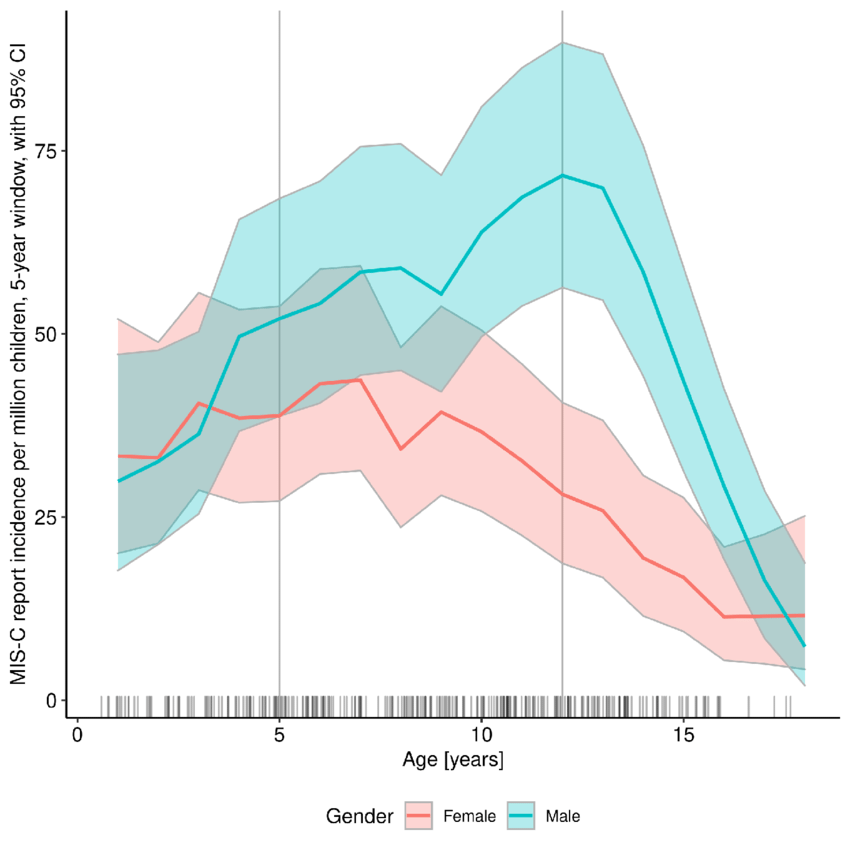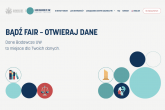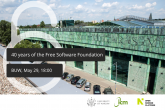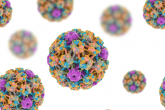Poland is one of the few countries with a registry and recommendations for treating post COVID-19 complications in children (PIMS)

Scientific Reports (part of the Nature portfolio) has just published the results of the joint work of scientists from the Wroclaw Medical University, the Medical University of Warsaw and the Interdisciplinary Centre for Mathematical and Computational Modelling of the University of Warsaw, on the NEW CONDITION – the paediatric multisystem inflammatory syndrome associated with COVID-19 (PIMS). This immunological complication of a previous SARS-CoV-2 infection affects approximately 1: 3,000 children, on average 4 weeks after infection.
Multisystem inflammatory syndrome in children (MIS-C) in Poland is more commonly known as the acronym PIMS – Pediatric multisystem inflammatory syndrome. The intensified inflammatory process affects the entire organism on average 4 weeks after having been infected with the SARS-CoV-2 virus. The most dangerous complication of PIMS is acute heart failure and coronary aneurysms.
The paper Distinct characteristics of Multisystem Inflammatory Syndrome in Children in Poland was published in the beginning of December 2021 in Scientific Reports. The authors of the publication are researchers from three universities: the Wroclaw Medical University, the Medical University of Warsaw and the Interdisciplinary Centre for Mathematical and Computational Modelling of the University of Warsaw, assisted by doctors and researchers from the Provincial Hospital in Wroclaw and the Institute of Biochemistry and Biophysics of the Polish Academy of Sciences. The interdisciplinary team of researchers began joint work on understanding the new disease entity in May 2020, after the first cases in Poland and the reports on PIMS in the international medical journals.
Data on PIMS in Poland are collected in the National Register of Inflammatory Diseases in Children, which is part of the MOIS-CoR (Multiorgan Inflammatory Syndrome COVID-19 Related) research project. Popular scientific information for parents as well as Polish and global PIMS management recommendations for doctors are available on the jointly maintained website: https://pimsudzieci.pl/ . 42 hospitals in Poland are already participating in the ICM UW – WUM – UWM studies.
Developing a statistical profile of a PIMS patient, capturing risk features, and finally data on the course of the disease and its consequences for children, are also the first stage of a research project carried out as part of scientific cooperation between the Medical University of Warsaw and the University of Warsaw (“Initiative of Excellence – Research University” program). The next stage is the search for genetic risk factors for PIMS – it will soon be possible to present the results of research in this area.
PIMS and Polish recommendations of conduct
Poland is one of the few countries in the world that has its own recommendations for the medical treatment of PIMS: Statistical characteristics of the course of the disease were possible mainly due to the systematic collection of data in the MOIS-CoR database.
As emphasized by the project leaders, the real culmination and proof of winning the race against time is the publication that has just been published in the Scientific Reports journal, describing the course of the disease in a population of 274 children with PIMS in Poland. Thus, scientists from Poland presented the most numerous database of PIMS cases in the world, after the United States of America and Great Britain.
“In the case of rare phenomena, creating an extensive database is difficult and requires the involvement of many people, but it is also extremely important. The experiences of individuals can be very different and lead to erroneous conclusions,” says, Dr. Kamila Ludwikowska from the Department of Paediatrics and Infectious Diseases at the Wroclaw Medical University.
“An additional challenge was the fact that when we designed the study, almost nothing was known about the new disease; we had to remain open to a lot of information,” adds Dr. Magdalena Okarska-Napierała from the Department of Paediatrics and Observation Ward of the Medical University of Warsaw.
Detailed description of PIMS in such a large population is a very demanding task. Both authors emphasize that they owe their progress to an extraordinary commitment of the pediatric community – the doctors filled the registry forms in a sense of solidarity in the fight against a new threat, often at the cost of their own free time.
“When we started the study, we did not expect so many cases of PIMS in Poland. About a month after the beginning of the fall’s COVID-19 wave in 2020, children with PIMS began to arrive in pediatric wards, it was a real ‘epidemic in the epidemic’ – said Dr. Magdalena Okarska-Napierała (MUW).
“PIMS is a serious disease that requires hospital treatment with the involvement of various specialists. In the US and the UK, at least half of the children with this diagnosis required treatment in paediatric intensive care wards, some of them required ventilation. In Poland, the percentage of children under intensive care was much smaller, less than 10 percent.” – adds Dr. Kamila Ludwikowska (UMW).
“When preparing the database assumptions, updating the adopted statistical model of data analysis and preparing the publication, we operated in almost real time conditions. New cases of patients were being entered by doctors all over the country in parallel with describing the population features of the cohort,” says Dr. Catherine Suski-Grabowski from the Interdisciplinary Centre for Mathematical and Computational Modelling of the University of Warsaw.
Different ethnic backgrounds can influence the course of PIMS
In the publication, the authors draw attention to a different ethnic background of the described group of patients compared to reports from other countries. This might affect the course of PIMS.
“Our study brings a valuable contribution to existing observations from other countries, mainly from the US and the UK. Like in those countries, MIS-C in Poland mainly affects school-age children. The most frequent symptoms include fever, skin and mucous membrane changes, abdominal symptoms and cardiac disorders. We have also observed a similar compilation of deviations in laboratory tests, including those with very high inflammation markers, a small number of lymphocytes, low serum sodium concentration. We were the first to show that not only age, but also sex can affect the occurrence and course of the disease, and the highest risk of acute cardiac complications concerns teenage boys,” says Dr. Okarska-Napierała.
Importantly from a practical point of view, thanks to the statistical solutions they used, the authors also managed to distinguish the diagnostic features of MIS-C associated with a heavier course of the disease already present on admittance to the hospital.
Next stage of work – genetic tests
The next step towards better understanding of PIMS will be conducting genomic tests to determine whether there are genetic and immune predispositions to develop this serious complication after SARS-COV-2 infection.
“At the same time, proteomic analyzes of plasma are carried out for a selected group of patients. We hope that multi-omic analyzes, including the clinical, epidemiological and environmental background, will allow us to refine the picture of the disease “- explains Dr. Catherine Suski-Grabowski (ICM UW)
Further research is the implementation of the project entitled “Identification of genetic factors of PIMS activation in Poland” and is financed under the program “Excellence Initiative-Research University”. The grant beneficiaries are the University of Warsaw and the Medical University of Warsaw; the project also includes the Medical University of Wrocław and Collegium Medicum of the Jan Kochanowski University in Kielce.
National Register of Inflammatory Diseases of Children
From May 2020, a national register of inflammatory diseases of children is maintained in Poland. The registry is part of the MOIS-CoR (Multiorgan Inflammatory Syndrome COVID-19 Related) research project. This project was initiated by doctors from two clinical centers – the Medical University of Wrocław and the Medical University of Warsaw, and was under the patronage of the National Consultant of Paediatrics. Scientists from the Interdisciplinary Center for Mathematical Modeling of the University of Warsaw have also joined the work on the register.
The study was approved by the Bioethics Committee at the Medical University of Wroclaw (CWN UMW BW – 39/2020), according to which each doctor may enter into the register information about the clinical history of his patient’s disease, provided that his / her personal data is kept anonymous (which is guaranteed via the register formula).
Project’s website: https://pimsudzieci.pl/
The authors of the paper:
Distinct characteristics of Multisystem Inflammatory Syndrome in Children in Poland
Scientific Reports 11, Article number: 23562 (2021)
DOI: https://doi.org/10.1038/s41598-021-02669-2
- Kamila Maria Ludwikowska , Department of Pediatric Infectious Diseases, Wroclaw Medical University
- Magdalena Okarska-Napierała, Department of Pediatrics with Clinical Assessment Unit, Medical University of Warsaw
- Natalia Dudek, Department of Pediatrics with Clinical Assessment Unit, Medical University of Warsaw
- Paweł Tracewski, Department of Pediatric Cardiology, Research and Development Center, Regional Specialist Hospital in Wroclaw
- Jacek Kusa, Department of Pediatric Cardiology, Research and Development Center, Regional Specialist Hospital in Wroclaw
- Krzysztof Piwoński, Interdisciplinary Centre for Mathematical and Computational Modelling, University of Warsaw
- Aneta Afelt, Interdisciplinary Centre for Mathematical and Computational Modelling, University of Warsaw
- Dominik Cysewski, Institute of Biochemistry and Biophysics, Polish Academy of Sciences
- Mateusz Biela, Department of Paediatrics and Rare Disorders, Wroclaw Medical University
- Bożena Werner, Department of Pediatric Cardiology and General Pediatrics, Medical University of Warsaw
- Teresa Jackowska, Department of Pediatrics, The Medical Centre of Postgraduate Education
- Catherine Suski-Grabowski, Interdisciplinary Centre for Mathematical and Computational Modelling, University of Warsaw
- Miron Bartosz Kursa, Interdisciplinary Centre for Mathematical and Computational Modelling, University of Warsaw
- Ernest Kuchar, Department of Pediatrics with Clinical Assessment Unit, Medical University of Warsaw
- Leszek Szenborn, Department of Pediatric Infectious Diseases, Wroclaw Medical University
Full list of authors and their affiliations appear:
https://www.nature.com/articles/s41598-021-02669-2#author-information





